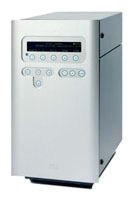DECADE II - Electrochemical Detector
DECADE II the best Electrochemical Detector ever built that fits any (U)HPLC. With more than 130 publications since 2011, highest sensitivity, versatility and ease of use are well demonstrated.

The DECADE II detector offers flexibility and stable working conditions for all applications using Electrochemical Detection (ECD). It can be used with any (U)HPLC system such as Waters, Thermo, Agilent, Shimadzu, Jasco, etc., to perform LC/ECD within a few hours after installation. It has a highly stable Faraday-shielded oven compartment accommodating the column and the electrochemical flow cell, to guarantee the highest stability. To achieve unprecedented sensitivity in LC/ECD the detector is equipped with a unique ADF filter to assure lowest noise level.
The DECADE II can control up to 2 flow cells. They can be used in a parallel or serial configuration. The flow cells are known for their robustness, ease in maintenance and come with a 5 years warranty. The DECADE II covers a broad range of applications in the DC, pulse and scan mode. The DC mode is used for many high sensitivity applications such as neurotransmitters, vitamins, phenols, etc. The pulse mode is important for PAD (Pulsed Amperometric Detection) used in the detection of carbohydrates. The scan mode is used to obtain a voltammogram in method optimization.
For more information please contact:
Antec BV
T: +31 (71) 581 3333
E:info@myAntec.com
W:ref="http://www.myAntec.com">www.myAntec.com
Removing Double-Stranded RNA Impurities Using Chromatography
April 8th 2025Researchers from Agency for Science, Technology and Research in Singapore recently published a review article exploring how chromatography can be used to remove double-stranded RNA impurities during mRNA therapeutics production.
The Effect of Time and Tide On PFAS Concentrations in Estuaries
April 8th 2025Oliver Jones and Navneet Singh from RMIT University, Melbourne, Australia discuss a recent study they conducted to investigate the relationship between tidal cycles and PFAS concentrations in estuarine systems, and offer practical advice on the sample preparation and LC–MS/MS techniques they used to achieve the best results.





